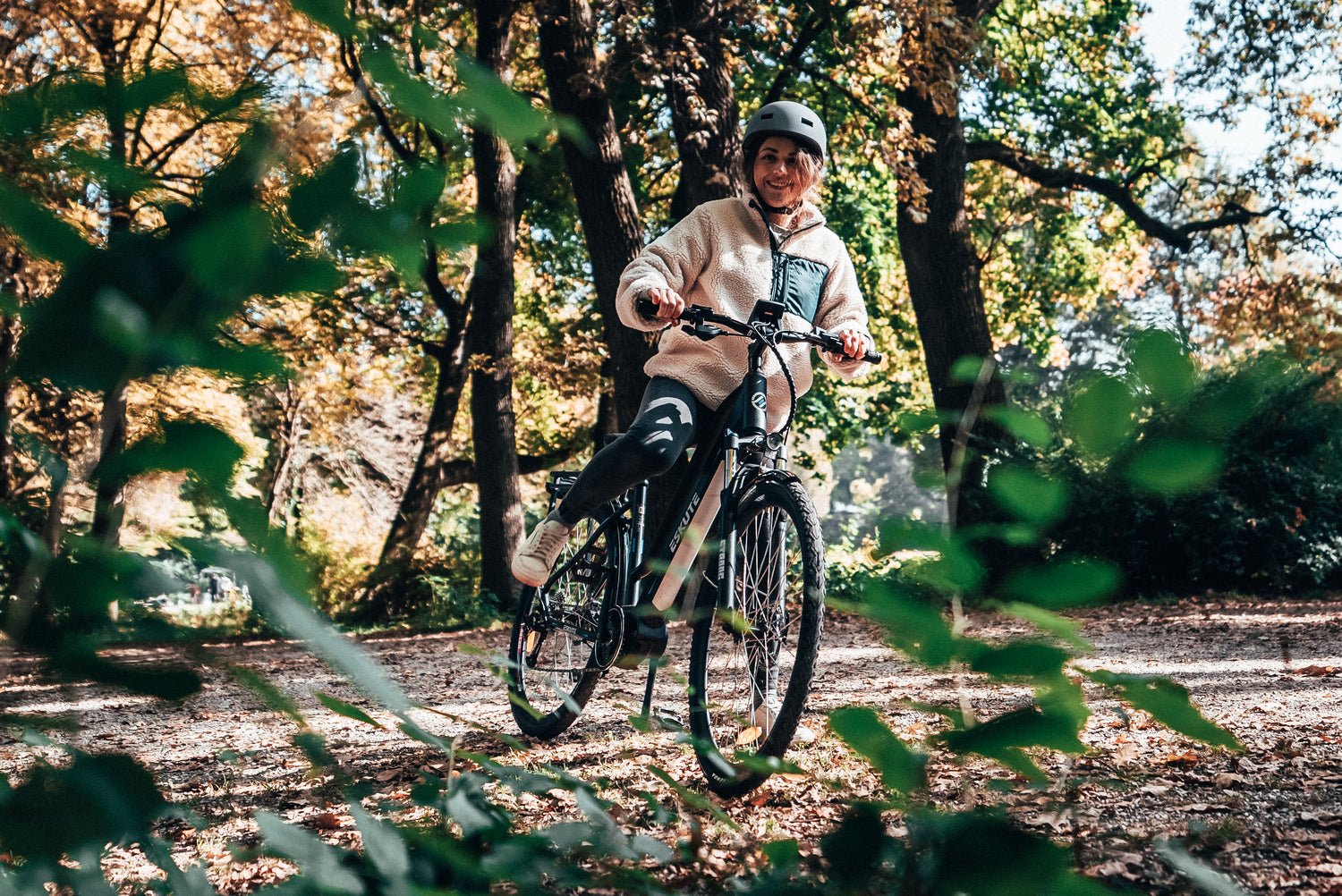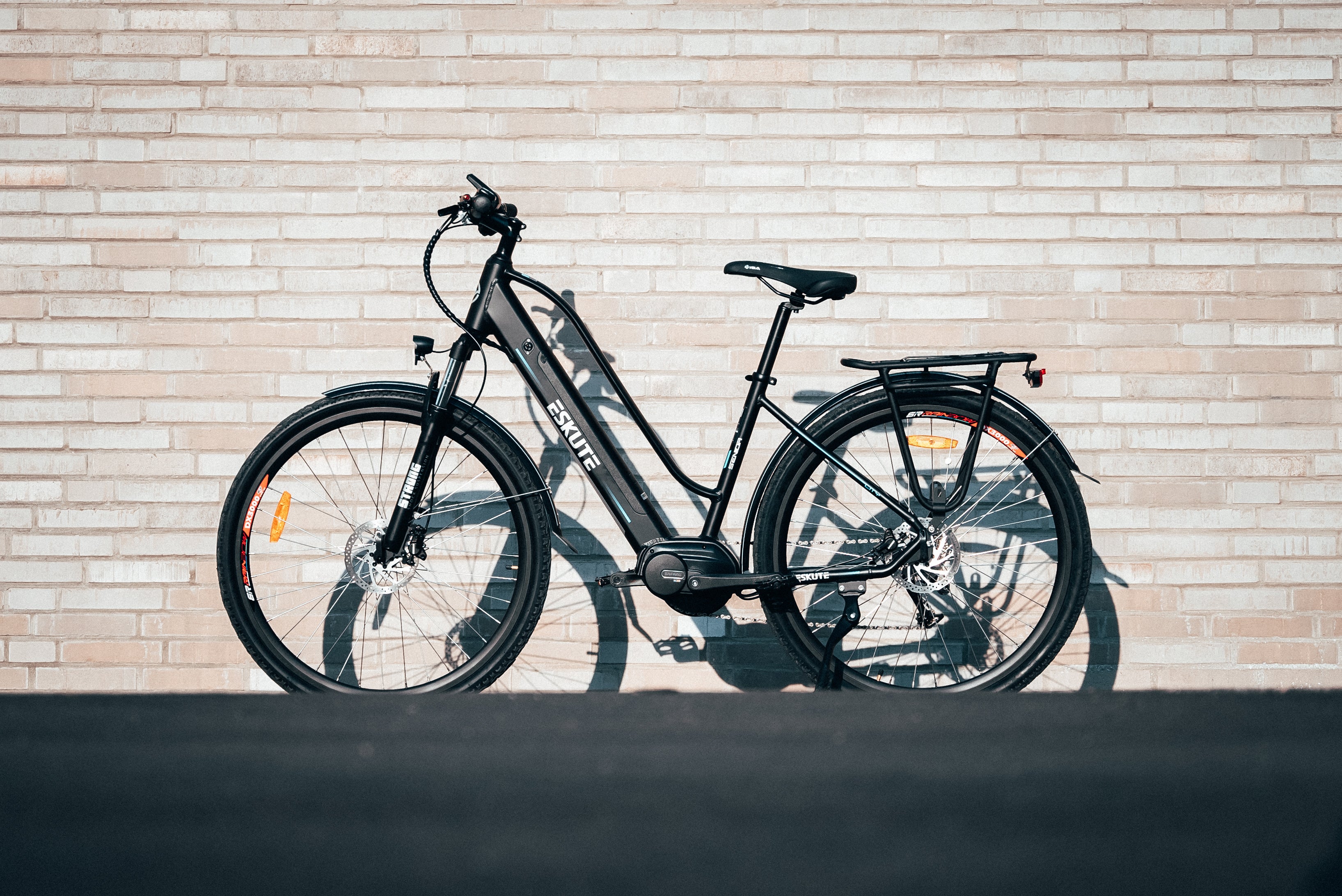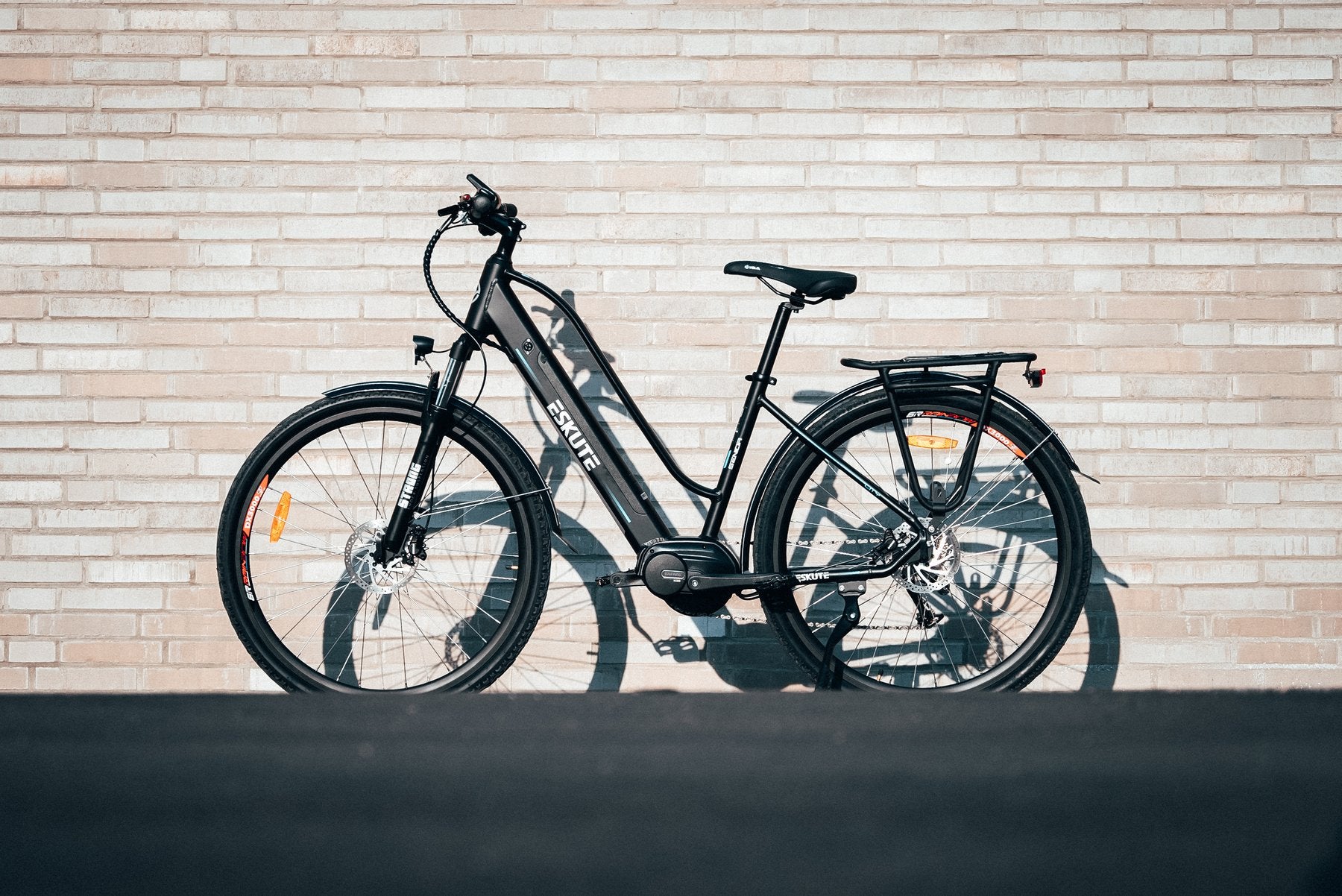Navigation
Winter is around the corner and cyclists are dawning their gloves and cozy scarves, bracing for colder rides. Many bikes are already sentenced to a garage hibernation and will be wheeled out next spring. But electric bikes can extend your riding season through these cold months! With the proper preparation, you can continue enjoying your e-bike all winter long. Your e-bike will help you spend less time pedaling hard and more time picking out that perfect sweater to keep out the frost. To make the most of winter, though, you should follow these tips on how to properly care for your e-bike when it’s chilly outside.
PREPARE THE ELECTRIC BIKE
First thing’s first, it’s best practice to give your bike a thorough clean before the start of the winter season. Your bike will need some much-needed TLC after surviving all of its summer adventures and autumn trails. Any drivetrain gunk or mechanical issues could be made worse by harsh winter conditions. Winter is infamous for heavy mud and slush which can get into the nooks and crannies of your precious ride. Water expands when it freezes so it’s a good idea to check that there aren’t any broken seals around the suspension or motor either.
CLEAN IS COOL
The good news, however, is that some bike shops offer tune-up specials during the winter since it’s a slow season for them. So go ahead and get your annual servicing and even if you don’t ride this winter, your bike will be ready to go when spring rolls around. If you don’t opt for a trip to your local shop, you can make a big difference at home by just cleaning your bike and removing any grime. Just don’t use a pressure washer around the bike’s electric motor. The housing is built to be durable and waterproof but a powerful jet of water aimed at the motor isn’t a risk any of us are willing to take. A good scrub of the bike will also give you a chance to see if there is any obvious damage or mechanical issues.
FRONT SUSPENSION
If your e-bike has a front suspension fork, you’ll want to make a couple adjustments. There’s oil in the fork and shock suspension system and the cold temperatures will thicken its viscosity slightly. Think of it like honey— honey runs quickly when it’s warm but moves slowly when its cooler. Move out the compression and rebound settings a bit from their normal levels and observe how the suspension feels when you’re riding. There are many factors at play in such a complex system so it might require a couple rounds of tweaking. Remember that an increase in temperature of the dampers during long descents or extended technical riding—even in the cold— will speed up the damping.
RUBBER REBOUND
Tire rubber also rebounds differently in the cold so set your winter suspension settings to compensate for that. Apart from keeping yourself clean (at least as much as possible) during the winter, a front fender can save your suspension fork. The muddy and gnarly conditions in winter can gunk up the seals and cause bigger problems down the road. A small fender in between the fork will deal with most of the debris quite easily.
BATTERY CARE
The most important part of maintaining your e-bike in the winter is protecting its battery. Batteries don’t do well in extreme conditions or temperatures. We all experience this phenomenon when our mobile phones run out of juice faster than usual during the winter. E-bike batteries lose performance at low temperatures, so keep your battery in the house or a heated garage. The rest of the bike will do just fine in the cold so if your battery is removable, just bring the battery inside to charge.
If you won’t be riding during the winter, check in on the battery every month to keep it at a mid-level of charge. Battery levels shouldn’t drop under 60% for an extended period of time so it’s best to add some charge every once in a while. Starving a battery of juice can decrease its long term life and performance.
Charging the battery should always happen at room temperature. After a ride, wait patiently for the battery to warm up before you plug it in. Don’t use another heat source like a lamp or fire to speed up the process as it could damage the components. Charging at temperatures between 10°C and 20°C preserves higher performance and cares for the complex inside parts. Be prepared for lower-than-normal battery range when riding your bike in cold conditions. Don’t worry though; that dip in performance is temporary and will return when the weather warms up again. To avoid that drop in range, you can put a neoprene cover around your battery to add a bit of protection from the cold— you can pick these up at your local bike shop.
APPROPRIATE TIRES
Winter can cover your local roads and trails with rain, ice, or snow, so proper tire choice makes a huge difference. Preparing your e-bike with the correct tires is a must for safety. For more grip, change from your slick commuter tires to heavier tread patterns that can channel water better and grip ice. You can purchase additional winter tires at your local bike shop— their expert staff will find the perfect match for your specific bike! A good tip is finding a set of tires that are wider than your summer ones, too. Wider tires hold more volume and can safely roll at a lower pressure in order to increase traction. Tires at low pressure better maintain traction while turning, which is often when winter accidents happen. That said, tire pressures that are too low put your tires at risk for pinch flats.
Common bike mechanics lore claims that temperature has a large effect on tires pressure but it’s actually a minuscule change. Extreme cold temperatures will only decrease the volume of air inside your inner tube by about 2%, or around 1 PSI. Cold conditions do, however, influence how the rubber in your tires rebound during the ride and on tough terrain. Adjust your suspension settings accordingly if you’ve got them.
Some conventional mountain bike tires are appropriate for winter but there are winter-specific options as well. If you ride in an area that has a constant layer of ice or snow, you can invest in some flashy yet effective studded tires. Embedded into the tread are tiny metal spikes that dig into hardpacked ice to prevent excessive sliding and spinning. Studded tires wear down fast on pavement and can damage dry surfaces so be careful. Overall, there several tire solutions to solve your winter worries but here’s a good rule of thumb: use tires with a heavy tread pattern and run them at a slightly lower pressure.
KEY COMPONENTS FOR A BETTER WINTER
Hub-Drive VS Mid-Drive Motors
While maintaining your battery and tires is the largest priority in the wintertime, there are some other essential components to your e-bike. E-bikes generally have one of two motor types: hub-drive or mid-drive. Mid-drive motors sit in the middle of the bike’s frame, between the pedals. That strategic placement keeps the bike well-balanced just like a normal bike. A mid-drive motor adds weight to an e-bike but keeps the handling natural so navigating ice or snow is a bit more manageable. Hub-drive motors, however, are positioned in either the front or rear wheel hub. Their placement can have a large effect on the balance and feel of the bike. A front hub-drive motor seems to ‘pull’ the bike forward while a rear hub-drive ‘pushes’ the bike. A front hub-drive performs better in snow and ice by pulling the rider forward with better straight line stability. Rear hub-drive motors work fine but the added power to the back wheel could lead to some donut spins on icy patches.
Robust and zippy e-bike motors are kept in check by strong braking systems. E-bikes are heavy machines and take even longer to stop in wet or icy conditions. Quality brakes can keep you and your bike safe and help you avoid winter mishaps. Many low- to mid-tier e-bikes are equipped with mechanical disc brakes, often with 160mm or 180mm rotors. While mechanical brakes work reliably in most conditions, low-friction winter riding can test your bike’s capabilities. Hydraulic brake systems are completely shielded from the outside elements and can produce stronger stopping power. But remember— good brakes won’t compensate for poor tire choice on ice and snow. The best approach is a solid combination of knobby, wide tires and trustworthy disc brakes.
MID-WINTER E-BIKE TLC
The winter season can be one of the toughest times to keep your e-bike looking clean and running smoothly. Here are some quick tips to boost the long term health of your bike even after winter ends. Be prepared to clean your bike more frequently. Rain and sleet transform dirt paths into sticky mud pits that can gunk up your entire drivetrain and wheel wells. Install a pair of fenders to keep yourself relatively clean and manage the bike’s dirtiness. That said, sometimes especially troublesome mud can wedge itself between the wheels and fenders. Rear fenders are a must if you often ride with others because no one wants to give a face full of mud to your mate who’s riding behind you.
Watch Out For Salt and Sand
Roads and trails in areas that experience heavy snowfall are often salted in order to prevent ice from forming. Some places opt for sand instead to add some traction above a layer of hardpacked snow or ice. Regardless, both salt and sand can wreak havoc on your bike if left untreated. Excessive exposure to salt and moisture can rust metal components. Bike shops stock rust proofing sprays to apply to certain parts of your bike in order to avoid this common corrosion issue. Sand can stick to the drive train and wear out the chain and cogs faster than normal. The best solution for both sand and salt is to clean your bike regularly. After particularly dirty rides, give your bike a quick, gentle rinse to get rid of the unwanted material. A little less regularly, you can thoroughly degrease and lubricate the entire drivechain. This routine will add longevity to your e-bike and set it up to sparkle in the spring.
E-Bike Storage In The Winter
While your battery should always be charged indoors, your e-bike can be stored anywhere. You can bring the whole bike inside as well or leave it in a cold garage. It’s best to keep your e-bike protected from the elements in order to avoid any rusting or ice buildup. There are mini outdoor shed options made of plastic or metal if you don’t have enough inside space. These solutions can keep your precious ride away from any potential thieves, too.
WINTER RIDING TIPS
Safe riding techniques can protect you and keep your bike in proper working order. Crashing on slippery ice can damage bike components but, more importantly, can also injure its rider. The powerful motor on e-bikes is normally a fun and carefree asset but can be a challenge in harsh conditions. Avoid the temptation to push speed limits on ice or snow and you’ll steer clear of most accidents.
Stay Visible
There are fewer hours of daylight in the winter, so powerful front and rear lights are necessary hardware. E-bikes often come with integrated lights powered by the battery but consider purchasing an additional front light and a rear helmet light. Bright lights reflect well on white surfaces like snow and allow other people to see you. Reflectors add another level of visibility. Many tire models incorporate a reflective strip around the sidewall to keep your bike illuminated from all angles. High-visibility clothing like neon or bright colors tack on additional insurance—and safety is always in style.
HAPPY TRAILS
Although the days are shorter and the temperatures have dropped, winter is a wonderful opportunity to continue enjoying your e-bike. E-bikes are uniquely prepared to lengthen your rides and add comfort to winter adventures you may have never thought were doable. But just like any bike or vehicle, some winter foresight and preparation will keep you out on the trails rather than stuck in the shop. Make sure to take special care with the electric battery and run high-traction tires at a lower pressure. Winter bike safety and maintenance is what’s in fashion this season, so you can finally throw out that hideous holiday sweater.











2 comments
Christopher Thomas Middleton
ERR 30 WHAT IS THE PROBLEM WITH VOYAGER ESKUTE BIKE
Christopher Thomas Middleton
ERR 30 WHAT IS THE PROBLEM WITH VOYAGER ESKUTE BIKE
Leave a comment
This site is protected by hCaptcha and the hCaptcha Privacy Policy and Terms of Service apply.